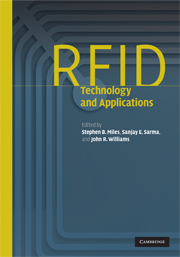Book contents
- Frontmatter
- Contents
- List of contributors
- Preface
- Acknowledgments
- 1 Introduction to RFID history and markets
- 2 RFID technology and its applications
- 3 RFID tag performance optimization: a chip perspective
- 4 Resolution and integration of HF and UHF
- 5 Integrating sensors and actuators into RFID tags
- 6 Performance evaluation of WiFi RFID localization technologies
- 7 Modeling supply chain network traffic
- 8 Deployment considerations for active RFID systems
- 9 RFID in the retail supply chain: issues and opportunities
- 10 Reducing barriers to ID system adoption in the aerospace industry: the aerospace ID technologies program
- 11 The cold chain
- 12 The application of RFID as anti-counterfeiting technique: issues and opportunities
- 13 Closing product information loops with product-embedded information devices: RFID technology and applications, models and metrics
- 14 Moving from RFID to autonomous cooperating logistic processes
- 15 Conclusions
- Appendix – links to RFID technology and applications resources
- Editor biographies
- Index
- References
10 - Reducing barriers to ID system adoption in the aerospace industry: the aerospace ID technologies program
Published online by Cambridge University Press: 02 November 2009
- Frontmatter
- Contents
- List of contributors
- Preface
- Acknowledgments
- 1 Introduction to RFID history and markets
- 2 RFID technology and its applications
- 3 RFID tag performance optimization: a chip perspective
- 4 Resolution and integration of HF and UHF
- 5 Integrating sensors and actuators into RFID tags
- 6 Performance evaluation of WiFi RFID localization technologies
- 7 Modeling supply chain network traffic
- 8 Deployment considerations for active RFID systems
- 9 RFID in the retail supply chain: issues and opportunities
- 10 Reducing barriers to ID system adoption in the aerospace industry: the aerospace ID technologies program
- 11 The cold chain
- 12 The application of RFID as anti-counterfeiting technique: issues and opportunities
- 13 Closing product information loops with product-embedded information devices: RFID technology and applications, models and metrics
- 14 Moving from RFID to autonomous cooperating logistic processes
- 15 Conclusions
- Appendix – links to RFID technology and applications resources
- Editor biographies
- Index
- References
Summary
Introduction
The five years from 2000 saw enormous developments in the way in which technologies such as RFID could be deployed in the consumer goods supply chain as illustrated in the preceding chapter (Ch. 9). While many of these developments were generic, it became increasingly clear that other sectors would need to make substantial adjustments were they to capitalize on the significant cost reductions and standards developments that had occurred. It was for this reason that the Auto ID Labs set up the Aerospace ID Programme. The aim of the programme was
To remove barriers to widescale automated ID deployment in the aerospace sector through timely and effective R&D.
The barriers to be examined ranged from issues of technical feasibility, via economic viability hurdles, to questions of operational viability – that is, whether solutions could survive a harsh range of operating conditions. These hurdles to be addressed (see Fig. 10.1) served as a sanity check for setting the research directions which are reported in Section 10.5.
This chapter tells the story of the Aerospace ID Programme, its formation, its operations, and the results.
Background
As mentioned above, the background to the Aero ID Programme was the major development in the use of RFID in the consumer goods industry, led by the Auto ID Center and exemplified by the major initiative from Wal-Mart in 2004.
- Type
- Chapter
- Information
- RFID Technology and Applications , pp. 121 - 143Publisher: Cambridge University PressPrint publication year: 2008



